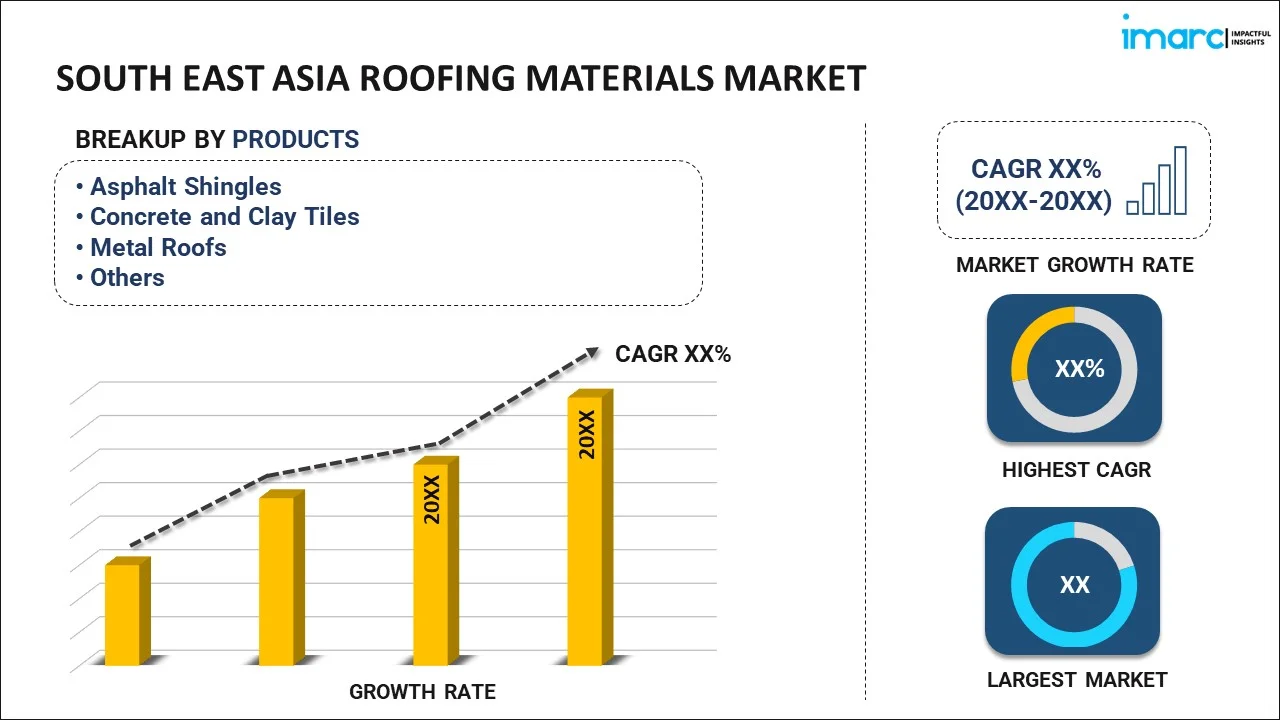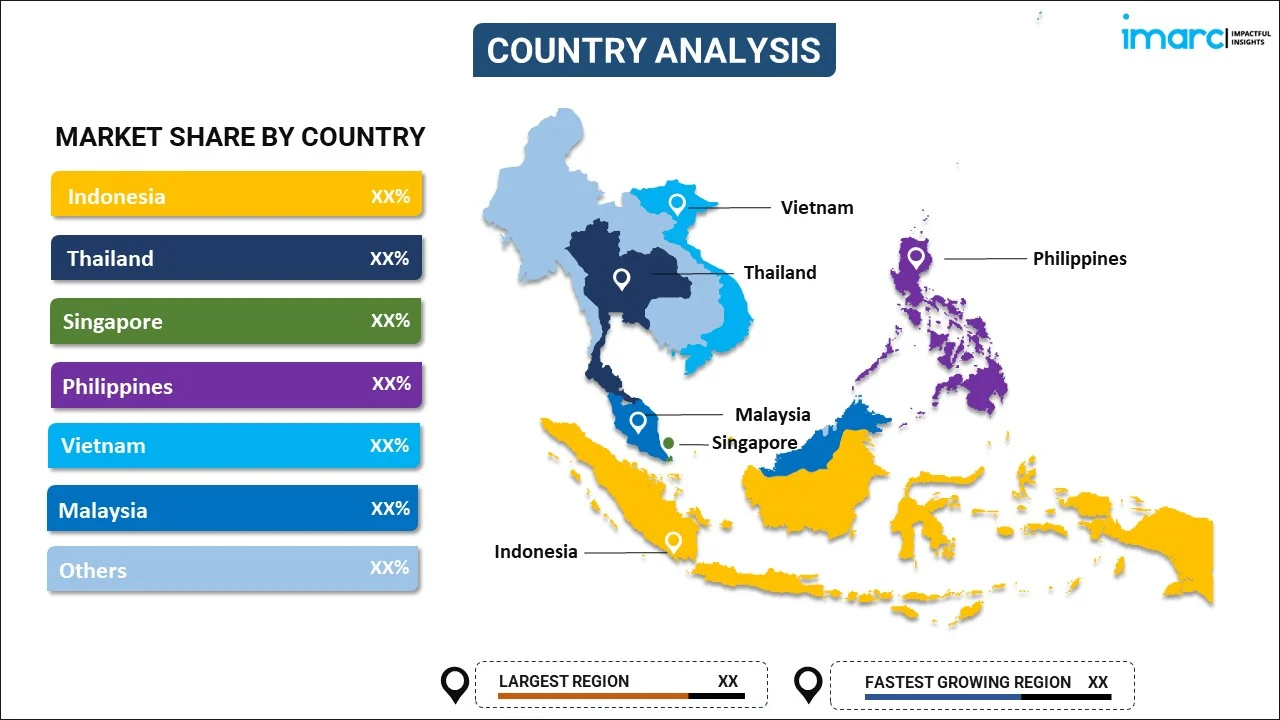
South East Asia Roofing Materials Market Report by Product (Asphalt Shingles, Concrete and Clay Tiles, Metal Roofs, Plastics, and Others), Construction Type (New Construction, Reroofing), Application (Residential, Non-Residential), and Country 2024-2032
Market Overview:
The South East Asia roofing materials market size is projected to exhibit a growth rate (CAGR) of 4.30% during 2024-2032. The increasing construction activities for residential, commercial, and industrial buildings, government investments in infrastructure projects, including roads, bridges, and airports, and the growth of e-commerce platforms and digital marketing represent some of the key factors driving the market.
|
Report Attribute
|
Key Statistics
|
|---|---|
|
Base Year
|
2023 |
|
Forecast Years
|
2024-2032
|
|
Historical Years
|
2018-2023
|
| Market Growth Rate (2024-2032) | 4.30% |
Roofing materials are construction materials used to cover the roof of a building or structure, providing protection from the elements and ensuring the building's integrity. Roofing materials are selected based on factors like climate, architectural style, budget, and durability. There is a wide variety of roofing materials available, each with its unique characteristics and advantages. There is a wide variety of roofing materials available, each with its own characteristics, advantages, and suitability for different applications. Asphalt shingles are one of the most popular and widely used roofing materials. They are cost-effective, easy to install, and come in a range of colors and styles. Asphalt shingles are known for their durability and resistance to weather conditions. Moreover, metal roofing materials, such as steel, aluminum, and copper, offer excellent longevity and durability. They are lightweight, energy-efficient, and resistant to fire, insects, and rot. Metal roofs are often used in residential and commercial buildings. On the other hand, synthetic roofing materials, such as synthetic slate or rubber roofing, replicate the look of traditional materials while offering improved durability, lower maintenance, and cost-effectiveness. The choice of roofing material depends on various factors, including climate, budget, architectural style, and specific requirements.
South East Asia Roofing Materials Market Trends:
South East Asia is undergoing rapid urbanization, with a surge in construction activities for residential, commercial, and industrial infrastructure. This construction boom is driving the demand for roofing materials, as new buildings and structures require roofing solutions. In addition, population growth in South East Asia is leading to increased housing needs and urban development. As more people move to cities, the demand for residential construction and, consequently, roofing materials is on the rise. Besides, South East Asia is susceptible to tropical storms, heavy rainfall, and other extreme weather events. Roofing materials need to withstand such weather conditions and provide protection against water infiltration and wind damage. This drives the demand for durable and weather-resistant roofing products. Moreover, there is a significant focus on renovating and retrofitting existing buildings to improve energy efficiency and safety. Many roofing materials are designed to enhance insulation and reduce energy consumption, aligning with sustainability and energy-efficiency goals. Additionally, government investments in infrastructure projects, including roads, bridges, and airports, often require roofing materials for transportation-related structures. This contributes to the demand for roofing materials in the infrastructure sector. Apart from this, the adoption of sustainable and environmentally friendly building practices is growing in South East Asia. Roofing materials that offer energy efficiency and sustainability features, such as cool roofs and green roofing systems, are gaining popularity. Furthermore, the growth of e-commerce platforms and digital marketing has made it easier for roofing material manufacturers and suppliers to reach customers and offer a wide range of products. Online platforms facilitate easier access to roofing materials and information.
South East Asia Roofing Materials Market Segmentation:
IMARC Group provides an analysis of the key trends in each segment of the market, along with forecasts at the regional and country levels for 2024-2032. Our report has categorized the market based on product, construction type, and application.
Product Insights:

- Asphalt Shingles
- Concrete and Clay Tiles
- Metal Roofs
- Plastics
- Others
The report has provided a detailed breakup and analysis of the market based on the product. This includes asphalt shingles, concrete and clay tiles, metal roofs, plastics, and others.
Construction Type Insights:
- New Construction
- Reroofing
A detailed breakup and analysis of the market based on the construction type have also been provided in the report. This includes new construction and reroofing.
Application Insights:
- Residential
- Non-Residential
The report has provided a detailed breakup and analysis of the market based on the application. This includes residential and non-residential.
Country Insights:

- Indonesia
- Thailand
- Singapore
- Philippines
- Vietnam
- Malaysia
- Others
The report has also provided a comprehensive analysis of all the major regional markets, which include Indonesia, Thailand, Singapore, Philippines, Vietnam, Malaysia, and Others.
Competitive Landscape:
The market research report has also provided a comprehensive analysis of the competitive landscape in the market. Competitive analysis such as market structure, key player positioning, top winning strategies, competitive dashboard, and company evaluation quadrant has been covered in the report. Also, detailed profiles of all major companies have been provided.
South East Asia Roofing Materials Market Report Coverage:
| Report Features | Details |
|---|---|
| Base Year of the Analysis | 2023 |
| Historical Period | 2018-2023 |
| Forecast Period | 2024-2032 |
| Units | US$ Million |
| Scope of the Report | Exploration of Historical and Forecast Trends, Industry Catalysts and Challenges, Segment-Wise Historical and Predictive Market Assessment:
|
| Products Covered | Asphalt Shingles, Concrete and Clay Tiles, Metal Roofs, Plastics, Others |
| Construction Types Covered | New Construction, Reroofing |
| Applications Covered | Residential, Non-Residential |
| Countries Covered | Indonesia, Thailand, Singapore, Philippines, Vietnam, Malaysia, Others |
| Customization Scope | 10% Free Customization |
| Report Price and Purchase Option | Single User License: US$ 3699 Five User License: US$ 4699 Corporate License: US$ 5699 |
| Post-Sale Analyst Support | 10-12 Weeks |
| Delivery Format | PDF and Excel through Email (We can also provide the editable version of the report in PPT/Word format on special request) |
Key Questions Answered in This Report:
- How has the South East Asia roofing materials market performed so far and how will it perform in the coming years?
- What has been the impact of COVID-19 on the South East Asia roofing materials market?
- What is the breakup of the South East Asia roofing materials market on the basis of product?
- What is the breakup of the South East Asia roofing materials market on the basis of construction type?
- What is the breakup of the South East Asia roofing materials market on the basis of application?
- What are the various stages in the value chain of the South East Asia roofing materials market?
- What are the key driving factors and challenges in the South East Asia roofing materials?
- What is the structure of the South East Asia roofing materials market and who are the key players?
- What is the degree of competition in the South East Asia roofing materials market?
Key Benefits for Stakeholders:
- IMARC’s industry report offers a comprehensive quantitative analysis of various market segments, historical and current market trends, market forecasts, and dynamics of the South East Asia roofing materials market from 2018-2032.
- The research report provides the latest information on the market drivers, challenges, and opportunities in the South East Asia roofing materials market.
- Porter's five forces analysis assist stakeholders in assessing the impact of new entrants, competitive rivalry, supplier power, buyer power, and the threat of substitution. It helps stakeholders to analyze the level of competition within the South East Asia roofing materials industry and its attractiveness.
- Competitive landscape allows stakeholders to understand their competitive environment and provides an insight into the current positions of key players in the market.
Need more help?
- Speak to our experienced analysts for insights on the current market scenarios.
- Include additional segments and countries to customize the report as per your requirement.
- Gain an unparalleled competitive advantage in your domain by understanding how to utilize the report and positively impacting your operations and revenue.
- For further assistance, please connect with our analysts.
 Inquire Before Buying
Inquire Before Buying
 Speak to an Analyst
Speak to an Analyst
 Request Brochure
Request Brochure
 Request Customization
Request Customization




.webp)




.webp)












